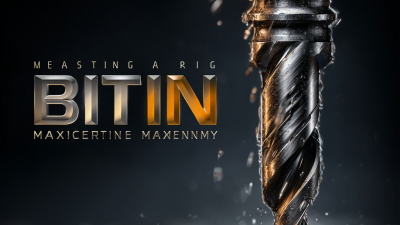Leave Your Message
As the cryptocurrency market continues to evolve, mining remains a critical aspect for investors seeking to capitalize on the potentials of Bitcoin. In 2023, the demand for efficient and profitable Bitcoin miners is more pronounced than ever. According to a report by Cambridge Centre for Alternative Finance, over 10% of the global electricity supply is consumed by Bitcoin mining, highlighting the intense energy requirements and the importance of choosing the right miner. Moreover, data from CoinShares indicates that over 40% of Bitcoin mining is being done using renewable energy sources, underscoring a shift towards sustainable practices within the industry.
In this competitive landscape, selecting the best Bitcoin miner can significantly impact an investor's profitability. As the Bitcoin network difficulty adjusts approximately every two weeks, miners must be equipped with advanced hardware that can withstand the challenges of fluctuating difficulty levels and energy costs. With various miners available on the market, understanding their efficiency, hash rates, and initial investments is essential for maximizing returns on investment. This article will explore the top 10 Bitcoin miners of 2023, paving the way for informed decisions that will enhance your mining endeavors in an increasingly dynamic sector.

When evaluating Bitcoin miners for maximum profit in 2023, two critical metrics come into play: hash rate and efficiency. Hash rate, measured in terahashes per second (TH/s), represents a miner's processing power, determining how quickly it can solve complex cryptographic challenges. According to the latest industry reports, the Antminer S19 XP, for instance, boasts an impressive hash rate of 140 TH/s while maintaining a power consumption of only 3250 watts, making it one of the top contenders in the market for both performance and profitability.
Efficiency, typically expressed as joules per terahash (JTH), is another essential factor to consider. This metric illustrates how much energy a miner consumes to produce its hashing power. A lower JTH indicates better efficiency. Currently, the Bitmain Antminer S19 Pro+ stands out with a remarkable efficiency of around 27.5 J/TH. This level of efficiency is pivotal for miners as energy costs form a significant portion of their recurring expenses. Advanced models with high hash rates and low energy consumption not only maximize mining rewards but also mitigate potential losses in an industry where electricity prices can fluctuate dramatically.
Mining pools play a crucial role in maximizing Bitcoin profits, especially as the industry's complexities grow. By pooling resources, miners can combine their hashing power to increase the likelihood of successfully mining blocks. This collaborative approach allows participants to earn more consistent rewards, even if they are operating with lower individual computational power. Mining pools typically operate on a reward-sharing system, ensuring that all members receive a portion of the mined rewards proportional to their contribution, which offers better returns compared to solo mining.
In the current landscape, understanding how to select the right mining pool can significantly impact profitability. Factors to consider include the pool's fees, payout structure, hash rates, and overall reputation within the community. A well-chosen mining pool can not only enhance earnings but also provide a sense of security as it distributes the risk and effort involved in Bitcoin mining. As the mining environment evolves with increased difficulty and regulations, aligning with a reputable and efficient mining pool can help maximize the chances of achieving consistent and profitable returns.
In 2023, the profitability of Bitcoin mining hinges significantly on the relationship between hardware costs, energy consumption, and the return on investment (ROI). According to the Cambridge Centre for Alternative Finance, the average cost of electricity for Bitcoin mining worldwide is approximately $0.05 to $0.07 per kWh. This figure underscores the critical need for miners to choose energy-efficient hardware to maximize profits. For instance, the Antminer S19 Pro, with a power consumption of around 3250W and producing approximately 110 TH/s, showcases an operational cost of roughly $9.60 per day at $0.07 per kWh, emphasizing the importance of effective cost management.
Moreover, the profitability of mining is further impacted by the Bitcoin network's difficulty and block rewards. With Bitcoin's halving event expected in 2024, the reward will decrease to 6.25 BTC per block. Miners need to consider not just the initial investment in hardware but also ongoing operational expenses. Data from Coin Metrics indicates that the average ROI for mining rigs ranges from 6 months to over 2 years, contingent upon market fluctuations and efficiency levels. Therefore, as miners assess their equipment choices, balancing upfront costs, potential profitability, and energy demands will be key to maximizing their returns in an evolving market landscape.
| Rank | Hash Rate (TH/s) | Power Consumption (W) | Price ($) | ROI (Months) | Energy Cost ($/kWh) |
|---|---|---|---|---|---|
| 1 | 110 | 3250 | 2,800 | 8 | 0.10 |
| 2 | 95 | 2800 | 1,900 | 9 | 0.10 |
| 3 | 105 | 3100 | 2,300 | 10 | 0.12 |
| 4 | 80 | 2400 | 1,600 | 11 | 0.10 |
| 5 | 90 | 2800 | 2,000 | 10 | 0.11 |
| 6 | 75 | 2200 | 1,400 | 12 | 0.09 |
| 7 | 65 | 1950 | 1,100 | 13 | 0.09 |
| 8 | 70 | 2100 | 1,500 | 11 | 0.10 |
| 9 | 60 | 1800 | 1,000 | 14 | 0.11 |
| 10 | 55 | 1700 | 950 | 15 | 0.12 |
When selecting the best mining software for optimizing performance in 2023, several key factors must be considered. One vital aspect is the hashing power, a measure of the number of computations a miner can perform per second. Data from recent industry reports indicate that mining software with robust capabilities can boost hashing efficiency by up to 40%, significantly impacting overall profitability in a competitive market. Therefore, miners must choose software that maximizes this metric while minimizing resource consumption.
Additionally, compatibility with various hardware setups plays a crucial role in mining efficacy. The latest studies reveal that software designed to work seamlessly with diverse mining hardware can yield a 25% increase in performance metrics. Moreover, user-friendly interfaces and real-time monitoring tools are now essential features for modern miners, enabling better management of mining operations. As the crypto landscape evolves, keeping abreast of software advancements and industry trends will help miners make informed decisions that drive their success.
In the rapidly evolving landscape of Bitcoin mining, staying competitive requires not just the right hardware but also a strategic approach. As difficulty levels soar and energy prices fluctuate, miners must adapt by optimizing their operations. One effective strategy is to invest in energy-efficient mining rigs that deliver maximum hash power while consuming less electricity. This dual focus on performance and efficiency can significantly reduce operational costs and improve profit margins.
Another critical aspect of maintaining competitiveness is diversifying mining activities. Miners can explore the option of joining mining pools to combine resources, increase their chances of earning rewards, and minimize the impact of volatility on their returns.
Additionally, staying informed on market trends, regulatory changes, and technological advancements will empower miners to make informed decisions. Regularly upgrading equipment and software can also help leverage enhancements that may offer significant advantages in processing capabilities and energy consumption. These proactive strategies can substantially enhance a miner's position in an increasingly challenging environment.






